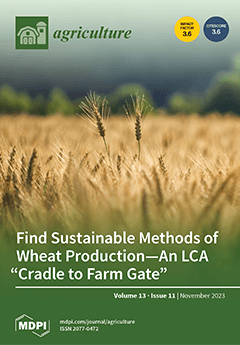The objective of this study was to evaluate the impact of the genotype on the chemical composition, feeding value and in vitro rumen degradability of fresh and ensiled forage of four native maize varieties (Amarillo, Olotillo, Tampiqueño and Tuxpeño) from Tamaulipas, Mexico, and a commercial hybrid, as well as the stability and aerobic deterioration of the silage. In all genotypes, fresh forage consisted of whole plants of maize that were harvested when the grain reached a milky-mass state, and silage was fresh forage chopped and ensiled in plastic bags, where it fermented for 120 days. The hybrid presented the highest content (
p < 0.05) of dry matter (DM), organic matter (OM), ether extract, non-fibrous carbohydrates (NFCs) and starch, as well as the lowest content (
p < 0.05) of fibers (NDF and ADF), acid detergent lignin and water-soluble carbohydrates (WSCs). Furthermore, the hybrid and Amarillo genotypes obtained the lowest pH and ammoniacal nitrogen content (
p < 0.05), intermediate values (
p < 0.05) of lactic and butyric acid, and the lowest and highest acetic acid content (
p < 0.05), respectively. Although OM did not differ (
p > 0.05) between states of the forage, the fresh forage presented a higher (
p < 0.05) content of DM, crude protein, NDF, ADF, WSCs, pH and butyric acid in all genotypes, while the rest of the parameters were higher (
p < 0.05) in the silage. However, Amarillo obtained the highest feeding value (
p < 0.05) in terms of DM intake, relative forage value, digestible energy, metabolizable energy and rumen degradability (DM, NDF and ADF), and between states of the forage, ensiled obtained the highest feeding value (
p < 0.05). During the aerobic exposure, the Amarillo and hybrid silage showed greater (
p < 0.05) stability (>38 h), and less (
p < 0.05) deterioration, pH increase and loss of DM and OM, while Tuxpeño obtained less stability and greater deterioration. In conclusion, the genotype did influence the chemical composition of fresh and ensiled forage, which affected the feeding value and in vitro rumen degradability, and the Amarillo and hybrid genotypes presented the best values in the evaluated parameters.
Full article





